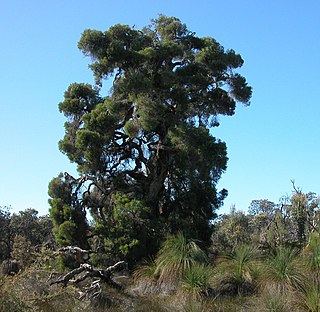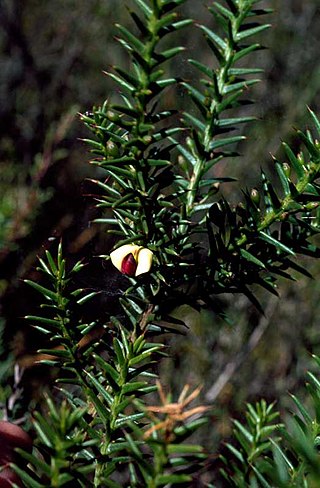
Melaleuca preissiana, commonly known as stout paperbark, modong or moonah, is a plant in the myrtle family, Myrtaceae and is endemic to coastal areas of southwest Australia. It is a shrub or small tree with papery bark, small leaves and spikes of usually white flowers. It occurs chiefly in areas that are seasonally wet.

Grevillea pulchella, commonly known as beautiful grevillea, is a species of flowering plant in the family Proteaceae and is endemic to the southwest of Western Australia. It is a spreading shrub usually with pinnatisect leaves, and cylindrical clusters of white to cream-coloured flowers.

Hakea costata, commonly known as the ribbed hakea, is a shrub in the family Proteaceae native to Western Australia. A multi-stemmed small shrub producing attractive pink or white brush-like blooms rich in nectar from July to October.

Grevillea trifida is species of flowering plant in the family Proteaceae and is endemic to the southwest of Western Australia. It is a spiny, erect to low spreading shrub, usually with divided, variably-shaped leaves, and clusters of white to cream-coloured flowers.

Hypocalymma cordifolium is a species of flowering plant in the myrtle family Myrtaceae, and is endemic to the south west of Western Australia. It is usually an low-growing shrub, but is sometimes erect, with winged stems, heart-shaped leaves arranged in opposite pairs, white or pale pink flowers mostly arranged in pairs in leaf axils, and fruit containing pearly white or pale brown seeds.

Conospermum canaliculatum is a species of flowering plant in the family Proteaceae, and is endemic to the south-west of Western Australia. It is a dense, multistemmed, erect shrub with linear leaves and spike-like panicles of woolly white, tube-shaped flowers.

Conospermum polycephalum is a species of flowering plant in the family Proteaceae and is endemic to the south-west of Western Australia. It is a spindly or semi-prostrate shrub with dense, thread-like leaves at the base of the plant, and panicles of white, pink or blue, tube-shaped flowers, the fruit a hairy, cream-coloured nut.

Jacksonia lehmannii is a is a species of flowering plant in the family Fabaceae and is endemic to the south-west of Western Australia. It is an erect to prostrate or spreading, spindly shrub with greyish-green branches, sharply-pointed side branches, its leaves reduced to scales leaves, yellowish-orange flowers with orange-red markings, and woody, hairy pods.

Daviesia hakeoides is a species of flowering plant in the family Fabaceae and is endemic to the south-west of Western Australia. It is a shrub with many tangled stems, scattered sharply-pointed phyllodes and yellow or orange and dark red flowers.
Bossiaea spinescens is a species of flowering plant in the family Fabaceae and is endemic to the south-west of Western Australia. It is a slender, spreading or compact, spiny shrub with oblong to oval leaves and yellow and reddish-brown, pea-like flowers.
Daviesia benthamii is a species of flowering plant in the family Fabaceae and is endemic to the west of Western Australia. It is an erect, bushy shrub with scattered, cylindrical, sharply pointed phyllodes, and yellow-orange and reddish-brown flowers.

Daviesia decurrens, commonly known as prickly bitter-pea, is a species of flowering plant in the family Fabaceae and is endemic to the south-west of Western Australia. It is spreading, erect, or low-lying shrub with scattered, sharply-pointed, narrow triangular phyllodes, and yellowish pink and velvety red flowers.

Eutaxia cuneata is a species of flowering plant in the family Fabaceae and is endemic to the south-west of Western Australia. It is a slender, upright shrub with red and orange pea-like flowers.

Daviesia preissii is a species of flowering plant in the family Fabaceae and is endemic to the south-west of Western Australia. It is a glabrous shrub with scattered, vertically flattened, tapering, narrowly egg-shaped to elliptic, sharply-pointed phyllodes and yellow and red flowers.

Daviesia spinosissima is a species of flowering plant in the family Fabaceae and is endemic to the south of Western Australia. It is a shrub with crowded, rigid, sharply-pointed, narrowly triangular phyllodes, and yellow and red flowers.

Daviesia trigonophylla is a species of flowering plant in the family Fabaceae and is endemic to the south of Western Australia. It is an erect, bushy shrub with elliptic or egg-shaped phyllodes that are triangular in cross-section, and orange, dark red and maroon flowers.

Jacksonia argentea is a species of flowering plant in the family Fabaceae and is endemic to the far north of Western Australia. It is an erect, silver-grey shrub with flattened, narrowly lance-shaped to narrowly elliptical cladodes or phylloclades, bright yellow flowers, and woody hairy pods.
Jacksonia arida is a species of flowering plant in the family Fabaceae and is endemic to Western Australia. It is an erect or prostrate shrub with tangled branches, sharply-pointed branchlets, yellow-orange to orange flowers, and woody pods.
Jacksonia carduacea is a species of flowering plant in the family Fabaceae and is endemic to the south-west of Western Australia. It is a bushy shrub with its end-branches elliptic to egg-shaped phylloclades, and yellow-orange flowers in clusters in the axils of phylloclades.
Jacksonia chappilliae is a species of flowering plant in the family Fabaceae and is endemic to a restricted area of northern New South Wales. It is an erect shrub with its end-branches sharply-pointed phylloclades, and yellow-orange flowers with red markings scattered along the branches.
















